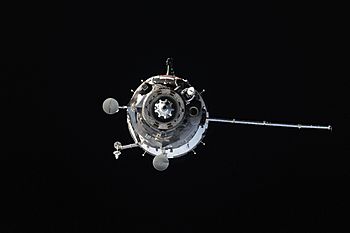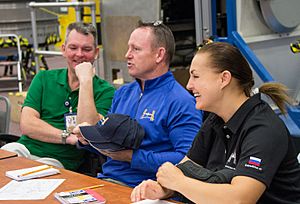Soyuz TMA-14M facts for kids

Soyuz TMA-14M approaches the ISS with port solar array retracted, 26 September 2014
|
|
| Operator | Roscosmos |
|---|---|
| Mission duration | 167 days, 5 hours, 43 minutes |
| Spacecraft properties | |
| Spacecraft | Soyuz 11F732A47 No.714 |
| Spacecraft type | Soyuz-TMA 11F747 |
| Manufacturer | RKK Energia |
| Crew | |
| Crew size | 3 |
| Members | Aleksandr Samokutyayev Yelena Serova Barry E. Wilmore |
| Start of mission | |
| Launch date | 25 September 2014, 20:25:00 UTC |
| Rocket | Soyuz-FG |
| Launch site | Baikonur 1/5, Kazakhstan |
| End of mission | |
| Landing date | 12 March 2015, 02:07 UTC |
| Landing site | Kazakh Steppe, Kazakhstan |
| Orbital parameters | |
| Reference system | Geocentric |
| Regime | Low Earth |
| Perigee | 176 kilometres (109 mi) |
| Apogee | 335 kilometres (208 mi) |
| Inclination | 52.06 degrees |
| Period | 89.48 minutes |
| Epoch | 25 September 2014, 20:13:36 UTC |
| Docking with ISS | |
| Docking port | Poisk zenith |
| Docking date | 26 September 2014 02:11 UTC |
| Undocking date | 11 March 2015 22:44 UTC |
| Time docked | 166 days, 20 hours, 33 minutes |
  (l-r) Samokutyayev, Wilmore and Serova Soyuz programme
(Crewed missions) |
|
Soyuz TMA-14M was a space mission in 2014. It carried three astronauts to the International Space Station (ISS). This flight was the 123rd mission using a Soyuz spacecraft. The very first Soyuz flight was in 1967. The Soyuz TMA-14M stayed connected to the space station. It served as an emergency escape vehicle for the Expedition 42 crew. It returned to Earth in March 2015, as planned.
Contents
Meet the Crew
This section introduces the astronauts who flew on the Soyuz TMA-14M mission. They were part of the Expedition 41 crew.
| Position | Crew Member | |
|---|---|---|
| Commander | Expedition 41 Second and last spaceflight |
|
| Flight Engineer 1 | Expedition 41 Only spaceflight |
|
| Flight Engineer 2 | Expedition 41 Second spaceflight |
|
Backup Crew Members
These astronauts were ready to fly if the main crew could not.
| Position | Crew Member | |
|---|---|---|
| Commander | ||
| Flight Engineer 1 | ||
| Flight Engineer 2 | ||
Key Moments of the Mission
Launch and Arrival at ISS
The Soyuz TMA-14M spacecraft launched successfully. It was carried by a Soyuz-FG rocket. The launch happened from the Baikonur Cosmodrome in Kazakhstan. This was on Thursday, September 25, 2014, at 8:25 PM UTC.
The spacecraft reached low Earth orbit about nine minutes after taking off. After getting into orbit, one of the Soyuz spacecraft's solar panels did not open right away. However, it did open after the spacecraft connected with the ISS. Space agencies like NASA said this problem did not affect the mission's success.
The spacecraft then traveled for about six hours. It connected with the Poisk module of the International Space Station. This docking happened at 2:11 AM UTC on Friday, September 26. The doors between the spacecraft and the ISS opened a couple of hours later. The TMA-14M crew then joined the Expedition 41 crew already on the ISS. They stayed there until the Soyuz TMA-13M crew left in November 2014. After that, Samokutyayev, Serova, and Wilmore became part of the Expedition 42 crew.
Returning to Earth
The TMA-14M spacecraft stayed docked to the ISS. It was there as a backup escape vehicle. On March 11, 2015, it undocked from the ISS at 10:44 PM UTC. It then brought Samokutyayev, Serova, and Wilmore back to Earth.
The spacecraft re-entered Earth's atmosphere. Its special descent module landed safely just over three hours later. The landing happened at 2:07 AM UTC on March 12, 2015.
In Media
- The 2014 film Gravity shows a fictional story. In the movie, Dr. Ryan Stone pilots a damaged Soyuz TMA-14M. She travels from the ISS to the Chinese Tiangong-1 station. She manages to control the spacecraft to separate its parts and use its landing rockets in space. This happens even though the capsule is out of fuel.
Images for kids
See also
 In Spanish: Soyuz TMA-14M para niños
In Spanish: Soyuz TMA-14M para niños






